Are you looking for a way to add a beautiful and unique plant to your home? If so, then the Philodendron Erubescens may be just the thing for you! This stunning tropical plant is an ornamental houseplant that has become increasingly popular in recent years.
It is often said that plants can have a calming effect on our emotions, and this is certainly true of the Philodendron Erubescens. Its vibrant green leaves can bring life into any room, while its complex root system symbolizes strength and stability. For those who are conscious of their environmental footprint, this plant also requires little maintenance and resources.
The good news is that it’s not hard to grow and care for a Philodendron Erubescens indoors if you know what you’re doing—so let’s dive right into it! We’ll discuss everything from choosing the right potting mix to proper watering techniques so that you can keep your Philodendron Erubescens healthy and thriving in your home.
Overview Of Philodendron Erubescens
The majestic Philodendron erubescens is a prized houseplant with its lush green leaves and deep red stems. This tropical plant can light up any home or office and bring joy to the people who care for it. With proper care, this beautiful plant will thrive and provide a wonderful natural addition to its surroundings.
The Philodendron erubescens is native to the tropical regions of South America, but it can easily be grown indoors in a pot with the right soil and watering conditions. It loves bright indirect sunlight, so make sure you keep it in an area where it won’t get too much direct sun or too much shade. The soil should be rich and moist, but not overly damp or soggy. Water regularly and make sure to empty out any standing water from the pot after each watering session.
With its hardy nature, the Philodendron erubescens is easy to take care of if you follow these basic guidelines. You’ll be rewarded with vibrant foliage that adds life and beauty to your living space. Now that we have an understanding of how this lovely philodendron grows, let’s explore what kind of light it needs to thrive!
What Kind Of Light Does Philodendron Erubescens Need?
Philodendron erubescens is a vibrant and attractive houseplant that’s easy to care for. Like many other houseplants, it needs the right amount of light to thrive. So what kind of lighting does this showy plant need?
It’s important to note that philodendron erubescens prefers indirect light, meaning it should be kept out of direct sunlight. Direct sunlight can cause the leaves to burn, so a room with bright but indirect light is best. A spot near an east or west-facing window works well. You’ll want to rotate the pot every month or two so all sides get light and avoid lopsided growth.
If you don’t have a bright enough window for your philodendron erubescens, you can supplement with artificial lighting. Fluorescent bulbs work great for providing indirect light, as long as they’re placed close enough to the plant (around 12 inches away). With any type of artificial lighting, make sure you turn it off at night – plants need darkness too!
Knowing what kind of light your philodendron erubescens needs is an important part of ensuring its health and beauty. Now let’s explore how temperature helps keep this attractive houseplant healthy…
What Temperature Is Best For Philodendron Erubescens?
When it comes to taking care of philodendron erubescens, many people often overlook the importance of temperature. But knowing the right temperature for Philodendron erubescens is essential to ensure its successful growth and health.
You might think that keeping your Philodendron erubescens at a higher temperature would be beneficial for its growth. But in fact, temperatures that are too hot can have an adverse effect on the plant’s wellbeing. This means you should avoid keeping your Philodendron erubescens in a place where temperatures exceed 80 degrees Fahrenheit (27 degrees Celsius).
On the other hand, temperatures that are too low can also cause problems for your Philodendron erubescens. The ideal temperature range is between 65-80 degrees Fahrenheit (18-27 degrees Celsius). So if you’re looking to give your plant the best chance of thriving, make sure it’s kept away from any draughts or chilly areas.
Providing your philodendron erubescens with the correct temperature will help keep it healthy and happy – so remember to check the thermometer before you decide on a spot for your plant! Now let’s move on to understanding how much water this plant needs…
How To Water Philodendron Erubescens
When it comes to looking after philodendron erubescens, watering is key. The good news is that these plants are pretty forgiving and easy to manage. With just a few tips, you’ll be able to give your philodendron the care it needs.
The best way to water your philodendron erubescens is to use room temperature water and avoid any cold or hot temperatures. Aim for once a week when the top inch of soil feels dry – if it’s too wet already, hold off on watering until it dries out a bit more. You can also check by sticking your finger into the soil; if it’s still damp, don’t water yet. Additionally, misting with room-temperature water daily can help keep the humidity levels up around your plant.
It’s important not to overwater your philodendron as this can cause root rot or other issues like brown tips or yellow leaves. To avoid overwatering, make sure you’re using well-draining soil and a shallow pot that won’t retain too much moisture. Philodendrons do need some moisture to stay healthy but make sure you’re not overdoing it!
Now that we’ve covered how to water philodendron erubescens, let’s move onto how best to fertilize them for optimal growth and health!
How To Fertilize Philodendron Erubescens
It’s important to fertilize your Philodendron Erubescens in order to ensure it stays healthy and grows properly. Fertilizing is simple and straightforward, but there are a few things to keep in mind.
First, you should only fertilize your Philodendron Erubescens once every two weeks during the growing season—spring through early fall. During the non-growing season, you should reduce this frequency to once per month or even less often. Second, make sure that the fertilizer you use is specifically made for houseplants. Third, dilute the fertilizer according to instructions; if you don’t, you risk burning your plant’s roots by overfertilizing.
Finally, when applying fertilizer to your Philodendron Erubescens, be sure to spread the solution around its base rather than pouring it directly onto its leaves. This will help prevent root burn as well as leaf damage from too much fertilizer buildup on foliage. With these considerations in mind, go ahead and give your Philodendron Erubescens some love! Now that we’ve discussed how to fertilize your plant properly, let’s move on to pruning it for maximum health benefits.
Pruning Philodendron Erubescens
Pruning philodendron erubescens may bring images of lush green foliage to mind, but the act of trimming is essential for keeping your plant healthy. Like a sculptor chipping away at marble, pruning helps you shape and control your Philodendron’s growth. Here are three key points to remember when pruning:
Prune in moderation – too much trimming can be damaging. Too little pruning may lead to an overgrown plant that takes up too much space or prevents light from reaching other parts of the pot.
Prune strategically – focus on removing yellow or dead leaves and stems, as well as any foliage that is growing outside of the desired shape.
Use clean tools – always disinfect your scissors or shears with rubbing alcohol before and after use to prevent damage from harmful bacteria or fungi.
These tips will help keep your Philodendron Erubescens looking its best and encourage new, healthy growth. To ensure that your plant continues to thrive, you’ll need to propagate it so that you can start new plants from its existing growth.
How To Propagate Philodendron Erubescens
Propagating Philodendron Erubescens can be a rewarding experience. With the right care and attention, you can create new plants to bring life to your home or garden. Let’s take a look at how you can help these plants grow in the best way possible.
Propagation involves taking cuttings from existing plants and helping them to form their own roots. The process is fairly simple and only requires a few materials. You’ll need a sharp pair of scissors, some soil, and a pot for the cutting to live in. Once you have all your supplies ready, it’s time to get started!
Take a cutting from an existing Philodendron Erubescens plant that is healthy and strong. Make sure that the cutting has at least two sets of leaves, both of which are fully intact. Place the cutting in the soil so that half of it is submerged beneath it. Keep the soil moist but not wet, as too much moisture can lead to root rot in your new plant. You may want to mist it regularly with a spray bottle filled with water. Your Philodendron Erubescens cutting should start forming its own roots within four weeks of planting – keep an eye on it!
With patience and proper care, propagating Philodendron Erubescens doesn’t have to be difficult or time-consuming. In no time at all, you could have an entirely new plant that adds beauty and life to any space!
Signs Of Stress In Philodendron Erubescens
Knowing the signs of stress in philodendron erubescens can help you take steps to ensure their health and longevity. While these plants are relatively low-maintenance, they still need attentive care and proper growing conditions. There are several key indicators that your philodendron is under stress.
One sign of trouble is when leaves turn yellow or brown, regardless of whether it’s a juvenile or mature plant. This could be due to an issue with the soil – either it doesn’t have enough nutrients or it’s too wet for the plant’s liking. If you suspect this is the case, check to make sure you’re properly fertilizing your philodendron and adjust watering levels if necessary.
Another potential sign of stress is when leaves start to curl up or become limp and droopy. This could mean that your plant isn’t getting enough light or too much direct sunlight. Make sure that your philodendron erubescens is receiving bright, indirect light and adjust as needed if leaves start to show signs of distress.
By keeping an eye out for these signals, you’ll be able to quickly identify any problems with your philodendron erubescens before they become serious issues. With the right care, you can keep this beautiful plant looking healthy for years to come! To further protect against disease and pests, let’s explore some common issues associated with philodendron erubescens.
Common Pests And Diseases Of Philodendron Erubescens
It’s important to be aware of the common pests and diseases that can affect philodendron erubescens. Some of the most frequent problems include root rot, fungal diseases, scale insects, mealybugs, and spider mites. If you’re not careful, these can quickly spread and cause serious damage to your plant.
To protect your philodendron erubescens from disease or pests, it’s important to keep the soil moist and well-drained. Make sure there is adequate air circulation so that any standing water or moisture doesn’t create a breeding ground for fungus or bacteria. Additionally, inspect your plant regularly for signs of infestation or disease.
The key to preventing and treating common pests and diseases in philodendron erubescens is to be proactive in monitoring the health of your plant. Keep an eye out for any signs of distress such as wilting leaves or discoloration. If you catch an issue early on, you’ll be able to take steps to correct it before it causes serious harm. With proper care and vigilance, you can ensure that your philodendron erubescens stays healthy and vibrant! Moving forward, let’s look at some tips for getting the best results when growing this beautiful houseplant.
Tips For Growing Philodendron Erubescens
Growing philodendron erubescens is a rewarding experience. Not only are they eye-catching and gorgeous, but they’re also relatively easy to care for. Here are some tips to help you get the most out of your philodendron erubescens:
- Provide bright, indirect light. 2) Keep the soil moist but not wet. 3) Fertilize every two weeks during the growing season with a balanced fertilizer diluted to half strength.
When caring for philodendron erubescens it’s important to remember that plants need plenty of humidity, so misting its leaves regularly is recommended. It’s best to use distilled or rain water if possible as tap water can contain salts and other minerals that can harm your plant over time. Additionally, make sure your plant is getting enough air circulation by not placing it in areas where there isn’t much airflow such as against a wall or window ledge.
Finally, make sure you are careful when moving or repotting philodendron erubescens as their stems are delicate and easily damaged. With these tips in mind, you’ll be able to enjoy a healthy and thriving plant! Moving forward, let’s look at the common uses for philodendron erubescens…
Common Uses For Philodendron Erubescens
Wow, if you thought philodendron erubescens was just a pretty houseplant, you couldn’t be more wrong! This unique species of Philodendron is actually incredibly versatile. Let’s explore some of the common uses of this plant.
To start off, I think it’s important to note that Philodendron plants are amazing air purifiers! They’re great for improving air quality in our homes, offices, and other enclosed spaces. In addition to being an effective natural filter for toxins and pollutants, they can also add humidity to the air. Now that’s what I call a win-win situation!
Philodendrons also make excellent hanging plants as they grow long vines that cascade downwards. If you keep them out of direct sunlight, you’ll have a beautiful green curtain with cascading leaves. Plus, if you have pets or children in your home, you don’t have to worry too much about potential health hazards since these plants are generally considered non-toxic.
But there’s one more – and arguably the most visually striking – use for Philodendrons: as climbing plants on walls or trellises! With careful pruning and training, your Philodendron can be trained to climb up walls or along trellises. And when it does get big enough? You’ll be left with a stunning living wall art piece that will bring life into any space.
Now that we know how versatile philodendron erubescens is, let’s move onto designing a space with this beautiful houseplant!
How To Design A Space With Philodendron Erubescens
Have you ever thought of using Philodendron Erubescens in your home decor? If not, then now is the perfect time to start! This stunning plant can be used to create a stunning display in any room. So, if you’re looking for something a little bit different and want to bring some color and life into your home, Philodendron Erubescens may be just what you need.
When it comes to designing with Philodendron Erubescens, there are a few things to keep in mind. One key factor is making sure that the spot where you plan to place the plant has enough light. This will ensure that your plant stays healthy and grows as intended. Additionally, it’s important to make sure the soil is kept moist but not overly wet as this can damage the roots. Finally, regular fertilization is also recommended for optimal growth.
Once you have taken care of all these considerations, it’s time to get creative with how you display your Philodendron Erubescens! You can choose from an array of colorful pots, or even hang it up on a wall for added visual interest. With its beautiful foliage cascading down from a high spot, it will undoubtedly become an eye-catching feature in any space. Experiment with different types of containers and locations until you find the perfect one that fits your style and taste!
How To Style Philodendron Erubescens
Styling your philodendron erubescens can create an eye-catching addition to your indoor space. Whether you’re looking to add color and texture to a room or simply want to give your plant a bit of extra attention, there are several ways to make the most out of your philodendron erubescens. Here are some tips for styling with this unique houseplant:
• Consider its shape – The philodendron erubescens is known for its climbing foliage and sculptural leaves. When styling with this plant, think about its size and positioning in the room. Depending on the height of the ceiling and the amount of sunlight in the space, consider adding a trellis or other structure to support its growth.
• Incorporate other plants – Create a mini jungle with other foliage plants like ferns and pothos. These plants will complement each other nicely and can create visual interest when grouped together in an area.
• Add decorations – For an added decorative touch, you can use accents such as stones, moss, twigs, or driftwood around the base of your philodendron erubescens. This will help enhance its beauty while also providing it with additional humidity protection.
• Accessorize – If you really want a pop of color in your space, consider using colorful pots or planters that contrast against the dark green leaves of the philodendron erubescens. You can even add touches like ribbons or macramé hangers for an extra special touch!
Style meets function when it comes to caring for your philodendron erubescens. With these tips, you’ll be able to create a unique look that not only adds aesthetic value but also helps ensure that your plant thrives indoors! From here, let’s move onto troubleshooting common issues with this houseplant so that you can keep it healthy and happy in any environment.
Troubleshooting Tips For Philodendron Erubescens
Troubleshooting philodendron erubescens can be a challenge, but with the right tips and tricks it’s easier than you think. Let’s go over some useful tips that can help you keep your philodendron healthy and thriving:
• Check for signs of pests or diseases. Look for yellowing leaves, wilting stems, or spots on the foliage. If you see any of these signs, treat the plant with an appropriate insecticidal soap or fungicide.
• Make sure your plant is getting enough light. Philodendron erubescens prefers bright, indirect light and should not be placed in direct sunlight—this can cause leaf burn.
• It’s important to water your philodendron correctly—too much or too little water can cause problems. Water when the top inch of soil has dried out, allowing the pot to drain freely afterwards.
• Fertilize your philodendron every two weeks during the spring and summer months with a balanced liquid fertilizer diluted to half strength. In fall and winter, reduce fertilization to once a month.
• Prune off any dead or damaged leaves as needed to keep your plant looking its best. You should also remove any yellowing leaves that are blocking the growth of new ones.
Proper care and attention will ensure that your philodendron erubescens remains healthy and vibrant for years to come! With just a few simple steps, you can enjoy this beautiful houseplant without having to worry about common issues like pests or diseases. Moving forward, let’s explore some of the benefits of growing philodendron erubescens in your home…
Benefits Of Growing Philodendron Erubescens
Philodendron erubescens is an attractive and easy to care for houseplant, making it a great choice for plant lovers of any level. Growing philodendron erubescens can provide many benefits. Not only can this tropical beauty bring life and beauty into a room, it can also help purify the air by filtering out pollutants like formaldehyde. Plus, these plants are low-maintenance and don’t need frequent repotting or pruning.
In addition to being aesthetically pleasing, philodendron erubescens is known for its stress-relieving properties. Keeping one of these plants in your home or office can help reduce stress levels and promote feelings of calmness and relaxation. They also have mood boosting benefits due to their natural ability to absorb carbon dioxide from the environment and release oxygen in return, promoting healthier air quality and better overall health.
Philodendron erubescens are not just great decorations for your home – they are packed with physical and mental health benefits too! With proper care, you can enjoy the lush foliage of this beautiful plant while reaping the rewards of cleaner air, improved moods, and lessened stress levels.
Frequently Asked Questions
How Long Does It Take For Philodendron Erubescens To Grow?
Imagery: Picture a lush and vibrant green Philodendron Erubescens, with its waxy leaves, as it takes its place in your living room.
The growth of a Philodendron Erubescens can be surprisingly fast. Depending on the conditions provided, the plant can reach up to 4 feet tall in just one year. To ensure the best growth rate, you should provide consistent temperatures between 65-75°F and bright, indirect sunlight. Water moderately but consistently – not too little and not too much – and fertilize about once every two weeks for optimal growth.
You may also need to prune it from time to time to keep it looking neat and tidy. Pruning is important as it helps promote healthy new growth and also keeps your plant from outgrowing its pot or space! Make sure to use clean scissors when pruning as this will prevent any potential infections or diseases from spreading.
TIP: Pay attention to how much water your Philodendron Erubescens needs – too little water leads to droopy leaves while overwatering can cause root rot. If you provide the right amount of light and moisture, your plant will thank you with plenty of healthy new growth!
Is Philodendron Erubescens Toxic To Pets?
Philodendron erubescens is a beautiful trailing houseplant, with red-tinted leaves that can grow up to four feet long. It’s surprisingly easy to care for and makes a great addition to any indoor garden. But one important question remains: Is philodendron erubescens toxic to pets?
Fortunately, the answer is no. Philodendron erubescens is non-toxic to cats, dogs, and even horses. In fact, there are very few houseplants that are actually toxic to pets–only around 10%. That means out of all the plants in your home environment, only a small fraction pose any risk!
So if you have furry friends in your home, you can rest assured knowing that philodendron erubescens won’t harm them. However, it’s still important to keep an eye on your pet when they’re around plants–especially if they like to chew on them. To ensure everyone stays safe and healthy:
• Monitor their behavior when they’re near plants t• Make sure they don’t eat any plant material t• Move potentially dangerous plants out of reach t• Regularly check for signs of ingestion like vomiting or diarrhea
It’s also wise to research any new plants before introducing them into your home. By taking these precautions and keeping philodendron erubescens away from curious noses and paws, you can make sure everyone stays happy and healthy–including your beloved pet!
How Can I Tell If Philodendron Erubescens Needs Repotting?
Curiosity and enthusiasm are often the keys to having a successful houseplant experience. When it comes to philodendron erubescens, you may be wondering how you can tell when it’s time for a repot. If this is the case, then you’ve come to the right place! Let me tell you about this captivating plant and how to recognize when it needs some extra TLC.
Philodendron erubescens is an attractive plant that can add a splash of color to any room. It has glossy heart-shaped leaves with bright pink veins and stems in shades of red or purple. This eye-catching beauty can be grown indoors or outdoors as long as its environment is warm and humid. The real challenge lies in figuring out when your philodendron erubescens needs to be repotted – but fear not, there are some telltale signs that will let you know when it’s time.
If your plant shows signs of distress such as wilting leaves or unhealthy root growth, then chances are that it’s time for a new pot. Additionally, if your pot feels light when lifted and your plant appears rootbound, then repotting may be necessary. To give your philodendron erubescens the best chance at success, make sure to use quality soil and a well-draining pot with plenty of drainage holes so that excess water doesn’t accumulate around the roots and cause root rot.
Taking care of philodendron erubescens requires patience and knowledge – but if you keep an eye out for these warning signs, you’ll have no trouble keeping this gorgeous specimen thriving in your home!
Are There Different Varieties Of Philodendron Erubescens?
Philodendron erubescens, a beautiful, vining plant native to South American rainforests, has been captivating homeowners for years. Its glossy, heart-shaped leaves bring a unique and vibrant energy to any room–but did you know that there are actually several different types of philodendron erubescens?
Just like with any other type of plant, each variety has its own unique needs and preferences when it comes to growing conditions and care. To the untrained eye, they may all look exactly the same–but the differences can be subtle.
Take the ‘Erubescens Red’ variety as an example. This variety is known for its deep red petioles (the stem from which the leaf grows). If you look closely, you’ll also notice that its leaves are slightly more pointed than those of other varieties. It’s also known for being somewhat slower growing than other philodendrons in this family.
TIP: Once you know what type of philodendron erubescens you have, research its ideal growing conditions and care needs so that your plant can thrive!
How Can I Tell If My Philodendron Erubescens Is Getting Too Much Light?
If you have a philodendron erubescens in your home, you may be wondering if it is getting the right amount of light. It can be tricky to tell, as these plants are quite tolerant of different light levels. However, there are some signs that your plant may be receiving too much light.
Having an eye on your philodendron erubescens is like having your finger on the pulse. If you notice its leaves becoming yellow, brown or bleached this could mean it’s getting too much sun. You may also find it wilting or even see its stem curling up and away from the light source. If any of these things happen, don’t panic – just move your plant to a spot with less light.
You can also tell if your plant is getting enough light by looking at its growth rate. Under optimal conditions, philodendron erubescens grows quickly and vigorously so watch out for this as a sign that it’s happy and healthy. On the other hand, if it’s not growing much or at all then you may want to consider giving it more light or adjusting its position in relation to the window or artificial lightsource.
So with all this in mind, keep an eye on your philodendron erubescens for any signs that indicate it might need more or less light – that way you will have a thriving indoor jungle in no time!
Conclusion
In conclusion, Philodendron Erubescens is a beautiful plant that can be grown indoors and cared for with relative ease. It can take up to three years for the plant to reach its full size, and it’s important to repot it as it grows larger. This type of philodendron can also come in different varieties, so you have plenty of choices when selecting one for your home. Lastly, it’s important to be mindful of the amount of light this plant receives; too much light can damage or even kill the plant.
Given all these considerations, is Philodendron Erubescens worth the effort? Absolutely! With a bit of care and attention, this gorgeous houseplant will thrive in your home or office and bring a little bit of nature indoors. And who knows – maybe you’ll get lucky enough to see those bright red flowers bloom!





























